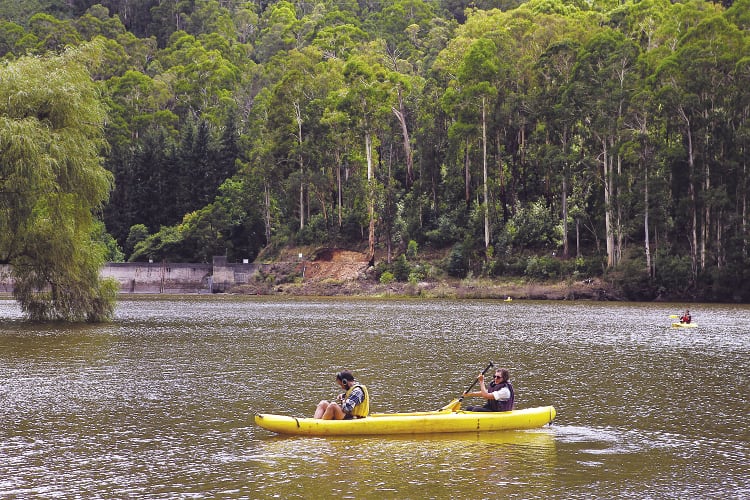A West Space off-site project, Bogong Alpine Village, Victoria, 19–20 February 2011
organised by Philip Samartzis and Madelynne

‘Site specific’ is a term that, through over- and inappropriate use, tends to become slightly meaningless; much like the term ‘sound art’. Nevertheless, site specificity has come to play a large and ever increasing role within contemporary sound practice. The *Bogong AIR Festival of Site Specific Sound Art* could be seen as adopting two main approaches. On the one hand, musicians were positioned directly within an environment, allowing the sonic properties and the context of the location to shape both their performances and our experience of them. On the other, artists were also selected to respond to the more conceptual nature of the site — focussing our attention directly on the environment itself, creating new contexts from which to hear and experience their work.
Bogong Alpine Village, in north eastern Victoria, is situated on the edge of Lake Guy, a large storage dam for the local hydroelectric scheme. My initial entry into the festival was standing inside the local ‘recreation centre’ dripping wet, being asked by Natasha Anderson and Jim Denley whether, despite the rain, we all still wanted to walk out to Junction Dam to hear them perform alongside Alice Hui-Sheng Chang and Rosalind Hall. Alternatively, if we preferred to stay dry indoors they could perform for us where we were. Of course, no one wanted to stay indoors. With site specific performance the audience contributes a lot to proceedings, becoming, in effect, an equal participant along with the artists and environment. The Bogong AIR audience were no exception. All were curious and eager to listen; to wander and explore.
Anderson, Denley, Hall and Hui-Scheng Chang replaced the concert hall with the insides of a dam and various locations around Lake Guy. This unusual setting allowed the sound artists to explore the physical characteristics of the large, cavernous dam and its ability to shape their sounds, whilst highlighting the way in which context contributes to how we hear. Indeed, one listens to music very differently while standing on a small rickety bridge in the rain with the water and trees as an accompaniment. However, one of the major problems with performing within such a location is the danger of either being dwarfed by the site, or by over playing and drowning out the sound of the place itself. And, while all the performers clearly attempted to allow room for us to hear the location, I was left with the feeling that I was not hearing the space itself as an equal participant, but simply a musical performance in an exotic location.
The second half of the festival dealt with artists responding to the site in a more conceptual or phenomenological way. Collecting and manipulating sounds from around the village, Slavek Kwi’s multi-speaker indoor performance drew attention to the connections between the electricity of the hydro scheme, the very electric-sounding insects and the water. At the same time, it transported us somewhere else entirely. On the other hand, Eric La Casa situated us in the middle of Lake Guy, paddling around in canoes with headphones on, listening to a darkly aquatic soundtrack that created a heightened awareness of the potential power of the lake; something we had already witnessed when rain caused the dam to burst its overflow wall the day before. Addressing the conjunction of nature and the built environment, La Casa and Kwi both challenged the audience to hear our location from a slightly different perspective, each in their own way highlighting the potential menace of the natural environment.
While I personally found these works far more interesting and engaging, it is a shame that Slavek Kwi could not have played inside the dam. His working methods would have made for a more interesting engagement with the space. And despite how much I enjoyed Eric La Casa’s piece, I could not help but wonder why a local artist was not invited, or at least someone like Kwi, who could have visited the site. It would seem that this would be an important feature of a site specific festival that calls itself an artists’ residency.
For all the strengths in each performance and presentation, the major success of the festival was its use of sound to bring an audience into a situation or site, opening them up to a series of different perspectives. While I found some works more successful than others, this became slightly irrelevant, as Bogong AIR was a conduit to experiencing location. Simply by travelling from one event to another we had to move through and interact with the village and its surrounds, as well as the ever changing weather. Being shown a bower bird’s intriguing collection of blue plastic objects in the pouring rain by one of the artists, whilst hearing Natasha Anderson faintly in the distance, was as important a part of the festival as anything else.
Eamon Sprod is based in Melbourne and works with sound under the name tarab.
